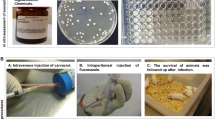Abstract
The effects of the immunosuppressive agents FK506 (tacrolimus) and cyclosporin (CyA) on Candida albicans infection in mice were compared with those of cyclophosphamide. FK506 and CyA did not exacerbate C. albicans infection in mice when the effects were determined on the basis of survival ratio and colony forming units (CFU) in the kidney, although cyclophosphamide (CY) impaired the host defence mechanisms of mice against C. albicans infection. The effects of FK506 and CyA on the body weight of mice, histopathological changes of lymphoid tissues and formation of granulomas in kidney were also studied in comparison with those of CY.
Similar content being viewed by others
References
Borel JF, Feurer C, Magnee C, Stahelin H. Effects of the new anti-lymphocytic peptide cyclosporin A in animals. Immunology 1977; 32: 1017–1025.
Calne RY, White DJG, Evans DB, Thiru, S, Henderson RG, Hamilton DV, Rolles K, McMaster P, Duffy TJ, MacDougall BRD, Williams R. Cyclosporin Ain cadaveric organ transplantation. Br Med J 1981; 282: 934–936.
Calne RY, Rolles K, White DJG, Thiru S, Evans DB, McMaster P, Dunn DC, Cradodock GN, Henderson RG, Aziz S, Lewis P. Cyclosporin A initially as the only immunosuppressant in 34 recipients of cadaveric organs: 32 kidneys, 2 pancreases, and 2 livers. Lancet 1979; 2: 1033–1036.
Starzl TE, Kintmalm GBG, Porter KA, Iwatsuki S, Schroter GPJ. Liver transplantation with use of cyclosporin A and predonisolone. N Engl J Med 1981; 305: 266–269.
Okuhara M, Goto T, Kino T, Hosoda J. Discovery and development of an immunosuppressant, Tacrolimus (FK-506). Nippon Nogeikagaku Kaishi 1996; 70: 1–8.
Odds FC. Pathogenesis of candidosis. In: Candidaand candidosis. Baltimore: University Park Press, 1979; 189.
Fulurija A, Ashman RB, Paradimitriou JM. Neutrophile depletion increases susceptibility to systemic and vaginal candidiasis in mice, and reveals differences between brain and kidney in mechanisms of host resistance. Microbiology 1996; 142: 3487–3496.
Giger DK, Domer JE, Moser SA, McQuitty Jr J T. Experimental murine candidiasis: Pathological and immune responses in T-lymphocyte-depleted mice. Infecti and Immun 1978; 21: 729–737.
Britton SR, Palacios R. Cyclosporin A – Usefulness, risks and mechanism of action. Immunol Rev 1982; 65: 5–22.
Bunjes D, Hardt C, Rollinghoff M, Wagner H. Cyclosporin A mediates immunosuppression of primary cytotoxic T cell responses by impairing the release of interleukin 1 and interleukin 2. Eur J Immunol 1981; 11: 657–661.
Palacios R. Cyclosporin A inhibits antigen-and lectin-induced but not constitutive production of interleukin 3. Eur J Immunol 1985; 15: 204–206.
Reem GH, Cook LA, Vilcek J. Gamma interferon synthesis by human thymocytes andT lymphocytes inhibited by cyclosporin A. Science 1983; 221: 63–65.
Odom A, Poeta MD, Perfect J, Heitman J. The immunosuppressant FK506 and its nonimmunosuppressive analog L-685,818 are toxic to Cryptococcus neoformansby inhibition of a common target protein. Antimicrob Agents Chemother 1997; 41:.156–161.
Chen H-Y, Kaneda S, Mikami Y, Arai T, Igarashi K. Protective effects of various BRMs against Candida albicansinfection in mice. Jpn J Med Mycol 1987; 2: 324–333.
Harding MW, Galat DE, Uehling DE, Schreiber SL. Areceptor for the immunosuppressant FK506 is a cis-trans peptidyl-prolyl isomerase. Nature 1989; 341: 758–760.
Siekierka JJ, Hung SHY, Poe M, Lin CS, Sigal NH. A cytosolic binding protein for the immunosuppressant FK506 has peptidyl-prolyl isomerase activity but is distinct from cyclosphilin. Nature 1989; 341: 755–757.
Liu J, Albers MW, Wandless TJ, Luan S, Alberg DG, Belshaw PJ, Cohen P, MacKintosh C, Klee CB, Schreiber SL. Inhibition of T cell signaling by immunophilin-ligand complexes correlates with loss of calcineurin phosphatase activity. Biochem 1992; 31: 3896–3901.
Liu J, Farmer JD, Lane WS, Friedman J, Weissman I, Schreiber SL. Calcineurin is a common target of cyclophilin-cyclospolin A and FKBP-FK506 complexes. Cell 1991; 66: 807–815.
Joyousinyakushu, Nihonnsinnyaku 1996; 34: 236.
Jensen J, Warner T, Balish E. Resistance of SCID mice to Candida albicansadministered intravenously or colonizing the gut: Role of polymorphonuclear leukocytes and macrophages. JID 1994; 167: 912–919.
Moser SA, Domer, J. E. Effects of cyclophosphamide on murine candidiasis. Infecti and Immun 1980; 27: 376–386.
Vecchiarelli A, Cenci E, Marcini P, Rossi R, Riccard C, and Bistoni, F. Immunosuppressive effect of cyclosporin A on resistance to systemic infection with Candida albicans. J Med Microbiol 1989; 30: 184–192.
Author information
Authors and Affiliations
Rights and permissions
About this article
Cite this article
Ito, E., Tanaka, Y. Influences of Immunosuppressive Agents, FK506 and Cyclosporin on Systemic Candida albicans Infection in Mice. Mycopathologia 138, 57–64 (1997). https://doi.org/10.1023/A:1006827828838
Issue Date:
DOI: https://doi.org/10.1023/A:1006827828838




